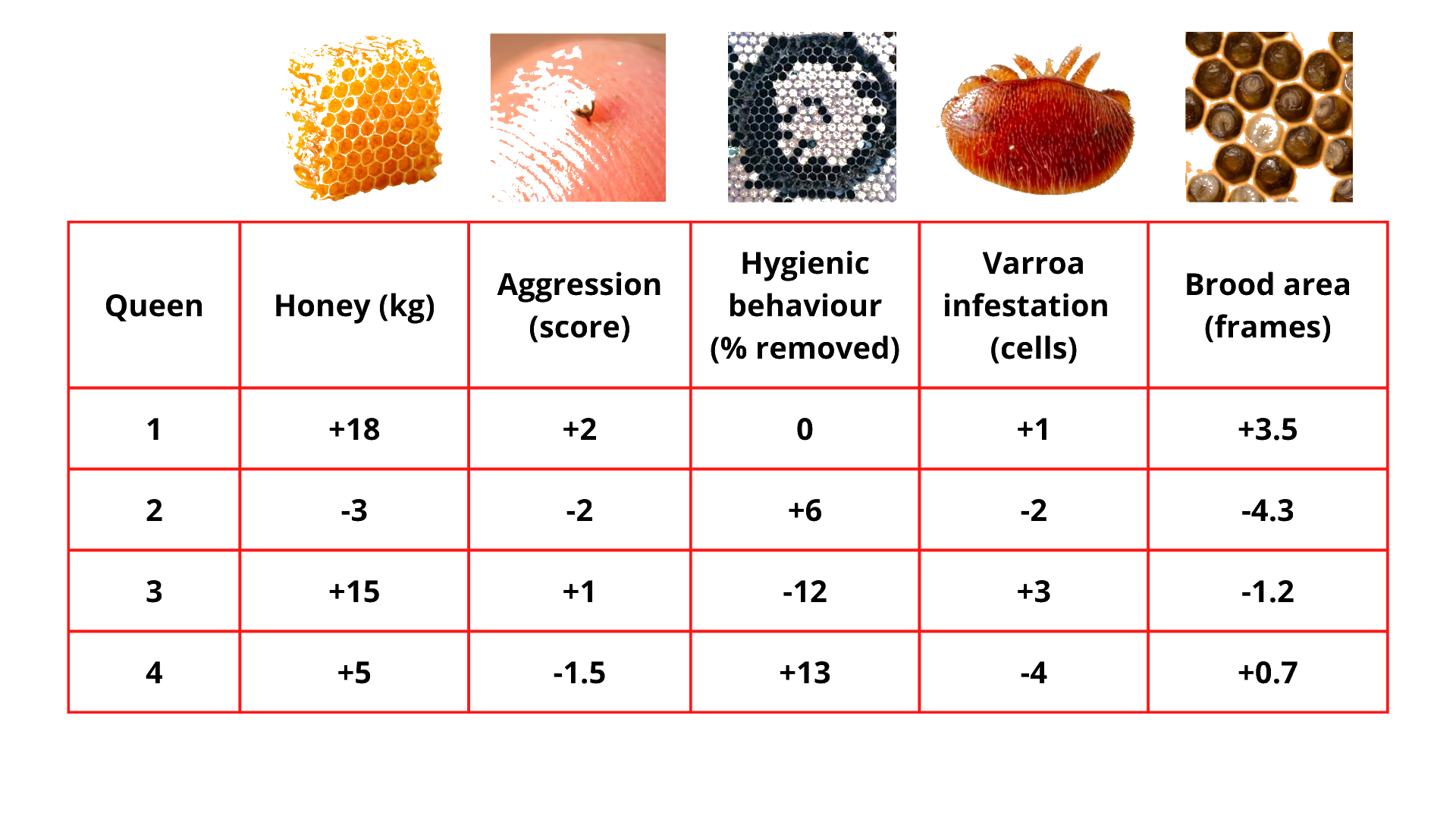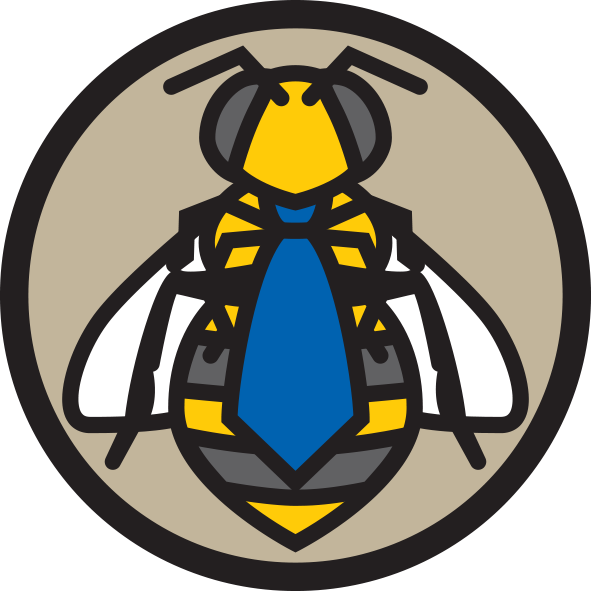Plan Bee is Australia’s honey bee genetic improvement program. This will provide bee breeders with Estimated Breeding Values (EBVs), a tool to aid with the selection of queens to breed the next generation from.
The variation in performance (phenotype) between colonies reflects the environment and genetics. Different traits vary in how much they are affected by each of these (Figure 1). Breeding can act only on the portion of variation that is due to genetics.

Figure 1. Performance (phenotype) is determined by genetics and the environment. In this example chalkbrood (left) and hygienic behaviour (right) are both partially controlled by genetics. However, genes have a greater effect on chalkbrood than on hygienic behaviour in this example
Whilst differences between colonies are observable without measurement of the trait, it is difficult to quantify the variation in performance between hives without records. The EBV describes how much of the difference in the observed performances between colonies is due to the genetic merit of the queen.
If you are choosing between queens, the difference in breeding values will reflect the expected difference in performance of the colonies when managed under the same environmental conditions (Table 1).

Table 1. Breeding values for four queens for five different traits, selected to show the range of different types of measures. A +18 for honey indicates that the queen has genes worth 18 kg more than the average at her apiary. A -3 indicates that the queen has genes worth 3 kg less than average at her apiary. Aggression is scored on a scale of 1 (low) to 5 (high); hygienic behaviour is scored as the proportion (%) of dead brood removed; Varroa infestation as the number of brood cells opened to find 10 Varroa mites; Brood area is scored as the number of frames of brood to the nearest 5%. There are other options for measuring some of these traits. Varroa resistance traits will be included in the next version of the Plan Bee Breeding Manual.
Which queen you would choose out of those available in Table 1 may differ from the queen someone else would choose. It depends on your breeding objective. One beekeeper may only care about aggression, so they would choose queen 2 as it has the lowest aggression score. Another beekeeper might care only about honey production, so they choose queen 1. Another may care most about hygienic behaviour and Varroa infestation, so they would choose queen 4.
What information do we need to produce an EBV?
Data. And lots of it!

Figure 2. Performance, pedigree and environmental data is required to produce Estimated Breeding Values
Performance data
Bee breeders should record the performance of all queens who are potential selection candidates from which the next generation of queens will be bred. Bee breeders should develop a routine recording practice that collects data on the traits that are important to the bee breeder’s breeding objective.
You can get a list of traits and the methods available for assessing them from the Plan Bee Breeding Manual.
Pedigree data
The genetic evaluation and the production of the breeding values is reliant on knowing the relationship between queens. A queen passes on genes to her daughters and as a result, the performance of her daughters will reflect the genes that were passed on from their mother. A group of sister queens should perform similarly because they have genes in common.
Most genetic evaluations are based around describing the relationships between individuals via a pedigree (progeny, queen mother). In bee breeding the pedigree will reflect the dam lines (queen mother and her daughters). Bee breeders should aim to provide the queen ID and her queen mother ID for all colonies with records.
More information on creating queen IDs is available in the Plan Bee Breeding Manual.
Genetic testing provides the opportunity to improve the ability to describe the genetic relationship between individuals as it allows for a more accurate modelling of the proportion of genes individuals have in common.
Currently, the genetic testing pathway is slow for honey bees, so it is recommended that producers continue to record queen pedigree even if samples are collected for genetic testing. In the long-term, genetic testing will provide the opportunity to understand the relationship between queens and colonies where the historic pedigree is unknown.
Environmental data
The performance of a colony or the phenotype you are recording reflects the environment and the genetic merit of the queen. Adjusting for environmental effects in a genetic evaluation is difficult as it is hard to quantify the impact of factors such as weather, access to pollen and location. Consequently, to account for these effects the analysis fits a contemporary group effect. The contemporary group describes a group of colonies that have been managed under the same conditions; in most cases this will be a load.
To help differentiate the impact of the environment of the load and the genetics of the queens within the load it is important to spread your genetics across loads. Don’t keep all the daughters of one queen in one load and the daughters of another queen in another load. Similarly, spread your lines (if you keep them) across your loads.
Each record should come with the following information: date of recording, apiary, load, colony ID, queen ID, ID of the person assessing the colonies, number and size of brood boxes and supers, and whether the queen is observed or not. More details on how to record the presence of the queen are available in the Plan Bee Breeding Manual.
Ideally, we will know the age of the queen and when she was introduced to the colony. We understand that you may not have this information when you’re starting out but encourage you to develop a system for recording this information. More information on recording age is available in the Plan Bee Breeding Manual.
How much data?
Developing breeding values is dependent on the collection and the compilation of informative records that encompass the diversity of queen genetics and the environments the hives are managed in. As you can imagine this will require a significant amount of data and the exact amount required will differ across traits. To get to a point where we can begin genetic evaluations and start the development of breeding values we are aiming for 500 to 1000 recorded individuals.
To help get the data to sufficient levels for a genetic evaluation and the development of breeding values it is important to make sure the data follows recording protocols, incorporates the diversity of queen lines available, and production environments.
How can we help bee breeders?
Plan Bee is here to assist bee breeders to collect data. We can assist you in taking records on colony performance and samples for free genetic testing. However, given the Varroa outbreak our capability to do this may be reduced.
We can also enter any colony performance and pedigree records into the database for you.
If you’re an Australian bee breeder and would be interested in having someone come for a site visit to assist you please fill in the online form or contact
na************@sy****.au
. We are particularly interested in working with breeders willing to collect a large number of records.
More information
Dr Nadine Chapman from the University of Sydney provides an overview of Plan Bee, Australia’s Honey Bee Genetic Improvement Program.
Estimated Breeding Values, Meat and Livestock Australia
Acknowledgements:
- Plan Bee (National Honey Bee Genetic Improvement Program) is supported by funding from the Australian Government Department of Agriculture, Fisheries and Forestry as part of its Rural Research and Development for Profit program. The project is further supported by AgriFutures Australia, the Department of Regional NSW, University of Sydney, University of New England Animal Genetics and Breeding Unit, Better Bees WA Inc, Wheen Bee Foundation, Costa Group, Olam, Beechworth Honey, Monson’s Honey and Pollination, South Pacific Seeds, Australian Queen Bee Breeders Association, Australian Honey Bee Industry Council, and commercial beekeepers.
- Chapman & Frost (2021) Plan Bee Breeding Manual. AgriFutures Australia
- This article was peer-reviewed by Elizabeth Frost and David Briggs.

